Supply Assistant David John Woolstencroft, HMAS Yarra, RAN
Born in Warragul, Victoria, on 25 January 1922, David Woolstencroft was the son of Bernard Woodall and Isobel Selby Woolstencroft. The family lived in Newport, in Melbourne’s west. David attended Neerim South State School, Noojee State School, and Mordialloc High School.
Four members of the Woolstencroft family served in the Second World War. The father, Bernard, a veteran of the First World War, enlisted again and served as a paymaster in Melbourne. His three eldest children also served: David in the Royal Australian Navy (RAN), Bernard in the Royal Australian Air Force, and Joan in the Women’s Auxillary Australian Air Force.
David Woolstencroft enlisted in March 1939, just before the outbreak of war. In November 1939, he joined the sloop HMAS Yarra. In August 1940, it sailed to the port of Aden to join Red Sea Force.
Over the next year, Yarra took part in patrols in the Indian Ocean and Persian Gulf. By November 1941, Yarra was in the Mediterranean, escorting convoys bringing supplies to the besieged garrison at Tobruk.
Following the outbreak of war in the Pacific in December 1941, the ship was sent to Java for escort duties between Batavia and Singapore. In February 1942, it helped rescue 1,800 survivors from the Empress of Asia, sunk by Japanese dive bombers near Singapore.
On 4 March, Yarra was escorting a small convoy of three merchant ships from Java to Fremantle when it was intercepted by five Japanese warships – three heavy cruisers and two destroyers. Yarra’s commanding officer, Lieutenant Commander Robert Rankin, tried to place the small sloop between the enemy and the merchant ships. Though outgunned and outranged, Yarra laid down a smokescreen and began attack.
The Japanese warships swiftly overwhelmed and sank the three merchant ships while inflicting devastating damage on Yarra. Shortly before being killed by a direct salvo to the bridge, Rankin gave the order to abandon ship. Burning fiercely and with its engine room and steering destroyed, Yarra was listing heavily and sinking at the stern.
Acting Leading Seaman Ronald “Buck” Taylor manned Yarra’s remaining gun and continued to fire until he was killed. His actions were credited by survivors for allowing them to reach life rafts and Carley floats. Shortly after, Yarra slipped beneath the waves.
Of the 151 crew, 138 were killed in the attack or later died on life-rafts. David Woolstencroft was among those killed. He was 20 years old.
Able Seaman Joseph F Murphy of the Royal New Zealand Navy later recounted:
“Silently we stood and watched that little sloop, white ensign flying and all guns blazing against the hopeless odds ... Hers was a gallant death of which Australia should be very proud.”
David’s death was not the only family tragedy during the war. In March 1945, his brother Bernard, a pilot in Bomber Command, was killed during an operation over Germany.
Lachlan Grant, Historian, Military History Section
Image: Port bow view of the Sloop HMAS Yarra II off Princes Pier, Port Melbourne, Vic. 1938.
- Australian War Memorial https://www.awm.gov.au/collection/C2133860

 Australian War Memorial
Australian War Memorial